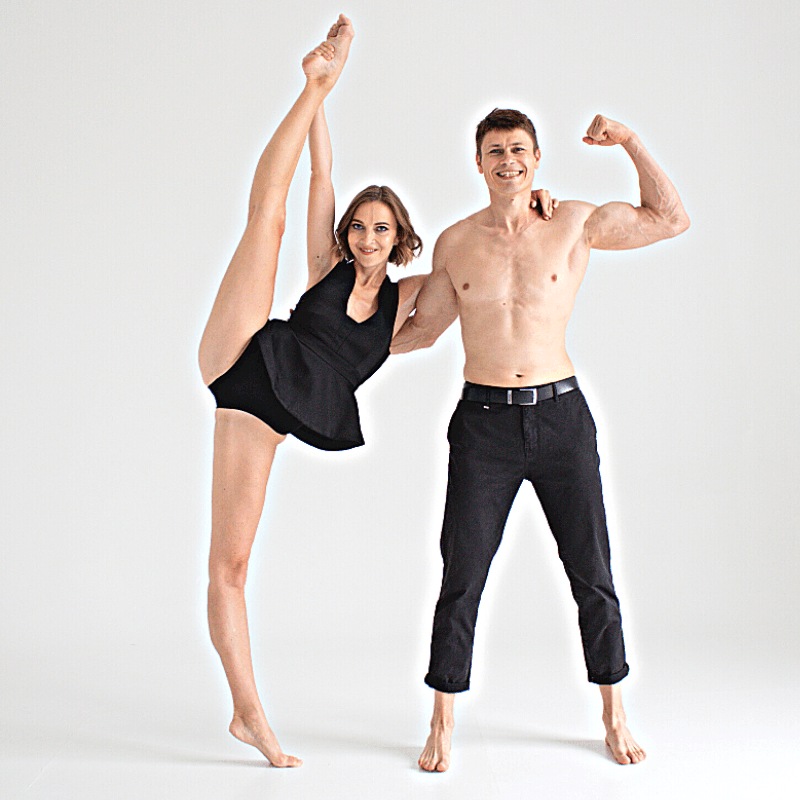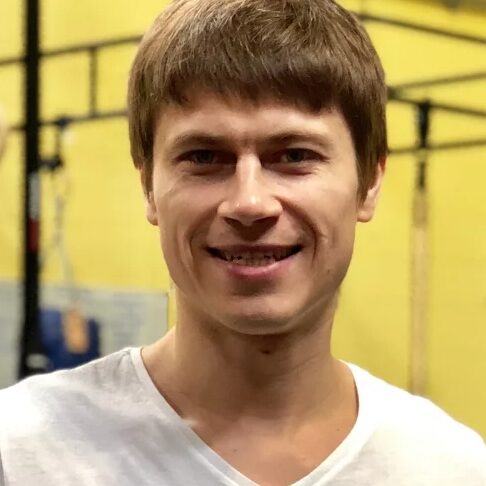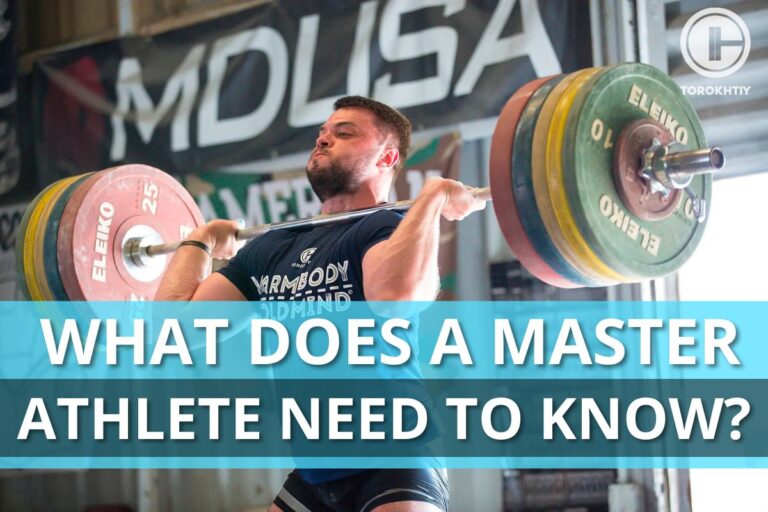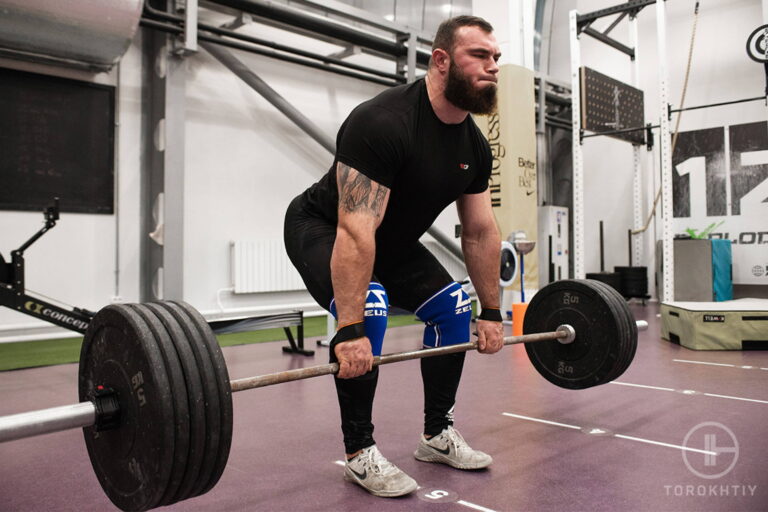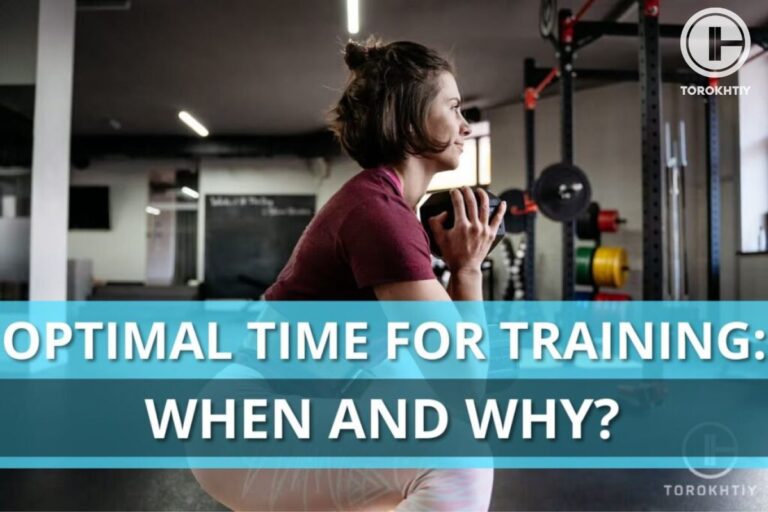From Zero to Front Splits: Unlocking Your Flexible Potential
Doing front splits will be easy, they said. Doing front splits won’t be hard, like at all, they said. Oh boy, were they wrong!
I’ve been an athlete most of my life. We’re looking mainly at weightlifting, fitness and living in the gym daily. And once I’ve decided to train to see if I’ll be able to do a front split, I thought that I’d have an advantage. Well… The first time I’ve actually committed and tried doing the front split, was I disappointed in how bad I was. I was nowhere near close to achieving a full front split. It wasn’t even close.
But, me being confident and perhaps a bit stubborn and all that – I wasn’t going to give up that easily. And, after a while, I’m happy to say, “I did it!” I did a full front split. Even Simone Biles would be proud. I think.
So here I am, writing about my experiences during this journey from zero to front split hero, about front splits in general – what they are, their benefits, risks involved, how to do them faster and some common frequently asked questions.
So, grab your mat, embrace the challenge, and let’s see how to do the front splits in a real-world scenario, not just a theoretical one.
What are front splits? Front splits, also known as front leg splits, are a flexibility exercise where one leg extends forward while the other extends backward, creating a straight line between them. It requires flexibility in the hip flexors, hamstrings, and adductors.

Front Splits: What Are They?
Front split is a leg-splitting position where one leg is extended forward, while the other leg is extended backward, thereby forming a line. You can do a left-leg front split, as well as a right-leg front split. But if you can do one, it doesn’t automatically mean that you can do the other one as well.
Your dominant leg, which extends forward, benefits from engagement from its quadriceps and hamstring, along with your hip flexors. The non-dominant leg is getting stretched out benefits through the glutes, hamstring, plus thigh muscles too. This collaboration of muscle sets helps create the ideal posture alignment required for splits practice
Continuous stretching routines concentrating primarily on your hips including both flexion or extension along with thighs, including adductors, can significantly influence flexibility improvement. This is achieved through better performance outcomes during such exercises.
Rome was not built in a day hence respecting your body’s type and ability as everyone needs to progress at their pace.
Why Are Front Splits Important in Gymnastics?
Can you seriously imagine gymnastics without splits? I know that I can’t. And front splits are one of several split variations that you can perform. Splits are not only attractive-looking, but they are a status sign for a gymnast’s agility, dexterity and overall flexibility and control over one’s body. And not only that. Once you actually try doing a split, you aslo quickly realize that there is that metal side of that coin as well. The sheer dedication and determination required to achieve a split – it’s immense. It is really hard to describe in words.
Imagine walking on glass barefoot. Your natural reaction when experiencing pain would be to back out and tend to your wounds, and of course – not do this again. Not with splits. With splits -? you persevere, and you fight through the slow and agonizing pain until a point where it stops hurting, and that hurt becomes something good and something that keeps you focused and on the right path. As I’ve said, “It’s hard to describe with words.”. But this is what first came to mind, so I guess I won a few points there.
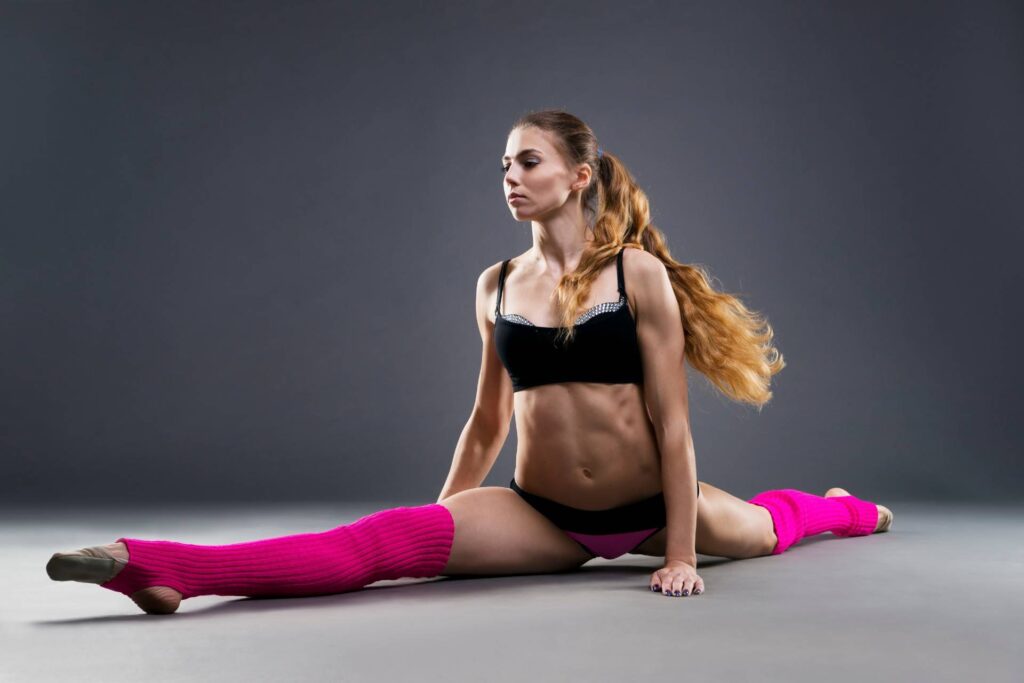
Physical Benefits
Physical benefits are those that we notice much easier, so I’ll list those first. In other words, I’ll talk about what being able to achieve the perfect front split is doing to your body.
1. Increased Flexibility
If not already obvious, doing a front split promotes flexibility. We are talking about muscles such as hip flexors, hamstrings and adductors. This increases your overall suppleness of your body.
2. Enhanced Leg Strength
Front splits require robustness in the quadriceps, hamstrings, and gluteal muscles. Building strength in these muscle groups can boost your overall lower body fitness and stability during gymnastics drills.
3. Improved Balance and Stability
To enhance their balance and stability while performing intricate skills and routines. Gymnasts can focus on practicing front splits. Doing so promotes the development of both core strength and proprioception.
4. Injury Prevention
Front splits hold great promise in preventing muscle strains or pulls, as well as boosting joint health. They achieve this by increasing flexibility and muscular power.
Mental Benefits
But, as I’ve said earlier – the front split benefits go way beyond just physical. There are a lot of mind games involved. Doing front splits offers immense cognitive rewards, including improved concentration, fearlessness, and lower stress levels. Moreover, reaching a state of proficiency demands discipline, which in turn instills valuable qualities like tenacity, stoicism and setting targets in an individual’s personality.
1. Concentration and Focus
Giving up is easy! And on the journey from not being able to do the front splits to achieving them you’ll get too many reasons to give up. Pain, discomfort, time, and slow results are just some of the critical factors involved. If you manage to not give up, but instead persevere and push through, you’ll get a beneficial boost to your concentration and focus that will last you a lifetime.
2. Confidence and Self-Esteem
Worth noting are also the boost to your confidence and self-esteem. From proving to yourself that you’re able to achieve something that you’ve set your mind to. Not only your self-acknowledgment. But also your colleagues, your peers, and your friends and family.
3. Stress Relief
Different people react in different ways when it comes to stress. If you’re often under stress for whatever reason, you’ll find comfort in the fact that making front stretches and even the journey towards a full front split will have a calming, stress-reducing, and overall soothing effect on your state of mind. So not only is your body getting better and stronger, but your mind is, as well.
4. Goal Setting and Persistence
The process of acing the front split is more than just a physical feat in gymnastics – it teaches athletes significant life lessons, such as the value of determination, patience, and having concrete objectives. This way of thinking yields positive results beyond the realm of sports into daily living as well. So, not only are you getting good returns to your body, but also your overall quality of life will increase as well.
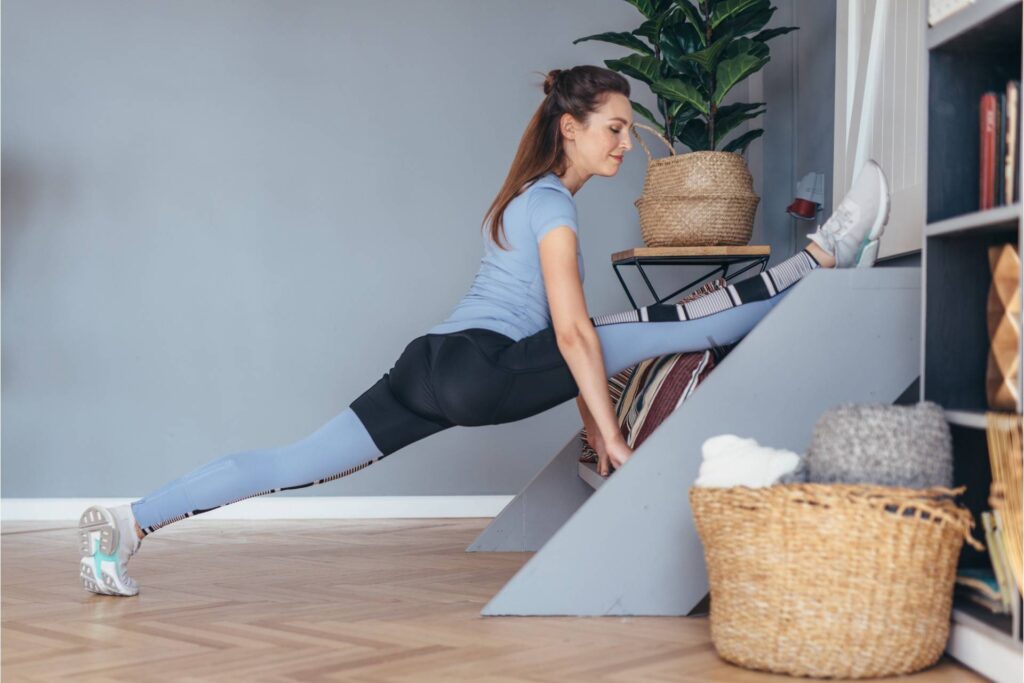
How to Do Front Splits Safe and Fast?
Many of us dream of achieving impressive feats like the front split swiftly without putting ourselves at risk of jeopardizing our health in the process. However admirable this may be – we must accept that mastery takes time and patient consistency rather than sprinting towards success with haste.
So, how to do front splits? While you can facilitate progress by actively working on techniques appropriate for your current level (both physically and mentally), one must recognize that endurance and persistence despite failures, play greater roles in achieving these challenging postures.
1. Warm-Up
Ensure that you are giving ample time for warming up before shifting focus on stretching your body parts. Leg swings, hip circles, and lunges can serve as an excellent way to prepare yourself by reducing muscle tension while enhancing blood circulation.
2. Gradual Progression
If you were thinking of starting today and getting to full front splits tomorrow, then you, unfortunately, got the wrong impression of the sheer scale and magnitude of what it means to get to perfect splits. It will take a long time, likely months. And during those months and usually daily exercising – the progression will be very slow.
In fact, so slow that sometimes you’ll have the feeling that you’re stuck in the same spot for what seems to be forever. Keep your chin up and confidence high because if you’re doing everything right, progress is there. It is gradual and in small increments – but you’re on the right track, and you’ll get there eventually!
3. Proper Alignment
To perform front splits safely and effectively, you need to take care of maintaining good body alignment. Keep your hips squared, spine elongated, and pelvis level throughout the stretch. Avoid overextending in any direction, which could potentially lead to pain in the lower back or hip joints.

4. Utilize Props
Yoga blocks, folded blankets, or towels were a definite favorite of mine during training sessions. I found that placing them under my hands as support or beneath a leg helped decrease the distance to the floor in a gradual manner. This aided in keeping my body aligned whilst improving my flexibility.
5. Active Stretching
Ready to take on a more challenging splits practice? Engaging and activating your muscles can make all the difference in deepening stretches and enhancing flexibility. Before you do any stretching, and this is paramount – do a proper warmup (10-20 minutes should do). After your muscles have been properly warmed up and prepared, you are safe to proceed with stretches.
Instead of settling for only a passive approach when transitioning into the split position, focus on pushing away with both legs as well as using muscular control throughout each movement. This intentional pushing is called ‘active stretching’. Through consistent practice this technique builds not only greater flexibility but also stronger muscles over time.
6. Post-Stretching Cool Down
Remember that cooling down is a vital component of any workout routine that should not be overlooked. Taking the time to do so can release built-up tensions and ultimately aid in muscle recovery. For my own post-workout cooldown routine I opt for gentle stretching coupled with relaxation exercises, as they tend to work wonders for me!
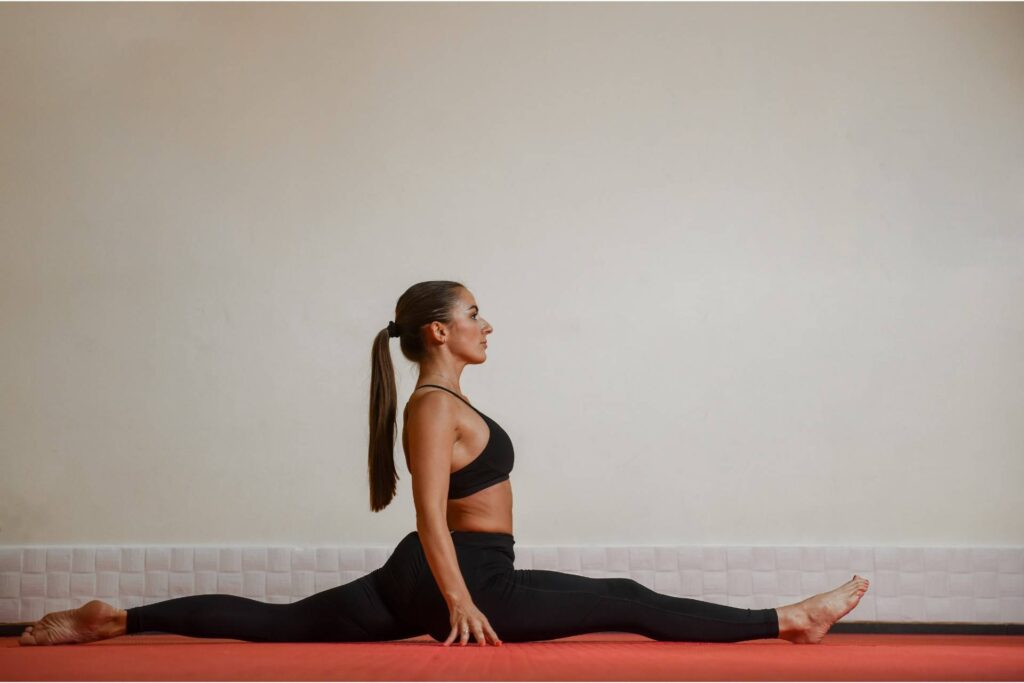
Risks of Making Front Splits
Doing splits, from nothing, can be dangerous if you’re not careful. Try pulling a piece of paper on each side, stretching it as hard as you can. See what will happen. Hint – It’ll break into two pieces.
It is a slow and gradual process that gets better in super small increments. In fact, so small that sometimes you feel like you’re standing in place. There is a lot of warming up involved. And a lot of stretching and waiting in uncomfortable positions while you’re trying to suppress the discomfort and pain. Is it easy? No. But, in the end – it is definitely worth it.
Let me walk you through some of the risks involved, just so you have a safer journey.
1. Muscle Strains and Tears
There’s nothing worse than a torn muscle. Ugh! Ok, I can think of a few things, but muscle tear surely tops the chart. While front splits are a popular flexibility exercise, they carry a notable risk of muscle strains or tears. To avoid injury, take care during warm-up and start by gently easing into the split position, progressing slowly until you reach your target flexibility level.
2. Joint Discomfort or Injury
Did you ever hear the phrase, “You can hear your bones clicking.”. Just the thought of that, accompanied by an imagined sound inside my head, sends shivers down my spine and makes me wobble like I’ve seen the most grotesque thing in existence. Executing proper front split stretches requires applying considerable stress to both your hip and knee joints. To prevent uncomfortable sensations or potential joint injuries, it is crucial you maintain optimal technique and alignment.
3. Overstretching Ligaments
People facing previous injuries or ongoing medical concerns impacting their flexibility, like muscle strains or joint issues, should exercise caution when trying front splits. These individuals may have a higher likelihood of sustaining an injury during the practice.
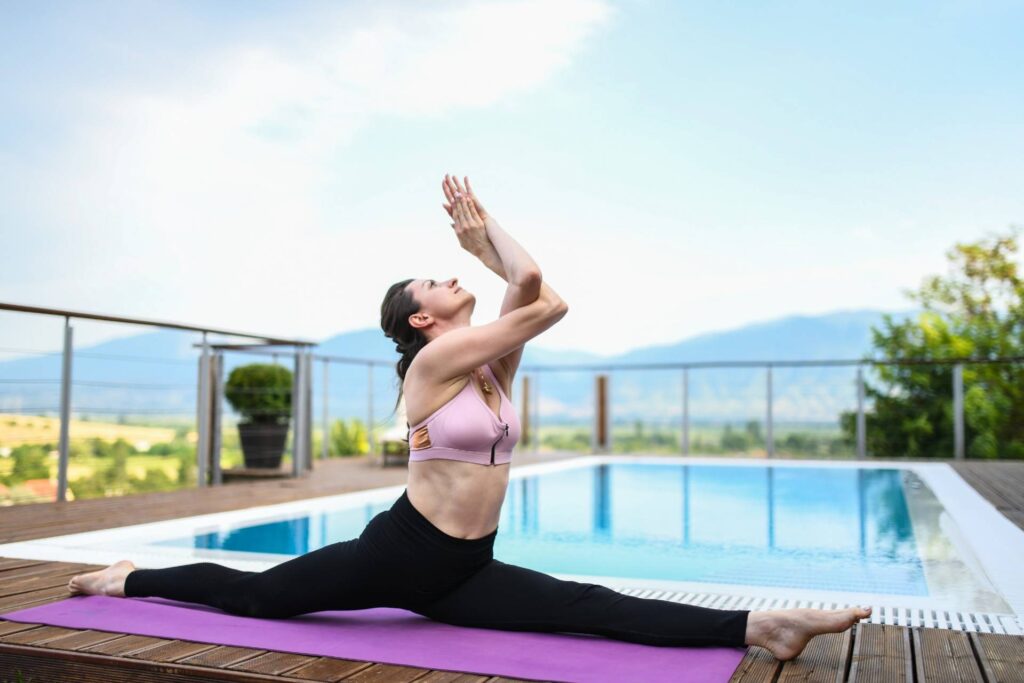
How to Improve Your Front Splits?
You deserve commendation for seeking ways to improve your proficiency in performing front splits. As someone who has attained this skill through sheer determination and practice. I would like to share some tried and tested methods that could assist you as well.
1. Targeted Conditioning
Achieving greater muscle strength for front splits requires performing targeted exercises that focus on engaging specific muscle groups. Emphasis should be put on exercises that involve the hip flexors, hamstrings, and adductors- leg lifts, standing leg extensions, and lateral lunges being some efficient ones.
2. Active Engagement
In order to optimize your split training incorporating muscle engagement is key instead of just depending on gravitational forces alone. You can accomplish this by pushing against the ground with your hands or utilizing your core and leg muscles for a deeper stretch.
3. Isometric Contractions
A good technique to improve strength and stability in the split position involves performing isometric contractions. Essentially, contract the relevant muscles by squeezing them tight for some seconds before letting go. This approach also offers visceral benefits such as enhanced control and flexibility.
4. Mindful Breathing
As you engage in split training, remember the significance of dedicated breathing practices. Taking intentional deep breaths can promote relaxation throughout your body and mind while also enabling deeper stretching.
5. Rest and Recovery
As with any physical activity – rest is super important! You need to give your body and muscles time to repair themselves and to attune to your new attained body upgrades. If you overdo it, without resting, the only thing you’d be doing is increasing the possibility of injury, and hindering or stagnating your progress.
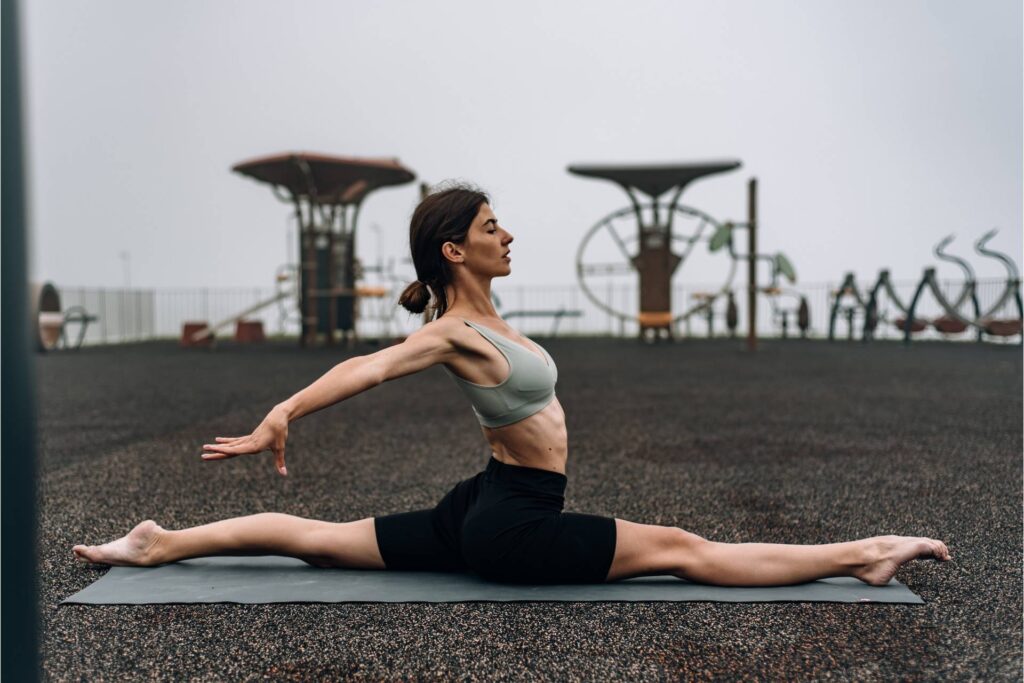
Can Children Make Front Splits?
Yeah, they can. The same as an adult can. But the real question you’re likely thinking is, “Are children better at splits than adults are?”. And the research is limited, and it goes in both the yes and no directions, with the final conclusions stopping at the word “plausable”. The plausibility, however, is due to the lacking of a large-scale research.
For example, a study done by Sports Medicine-Open done in 2022, suggest that there is a window of opportunity where promoting flexibility in humans is a bit easier. And that window of opportunity is closer to a child’s age than it is to an adult. The reasons behind that are uncertain and inconclusive.
But there are theories that the lack of a stretching volume load effect in adolescents may be due to the faster linear growth of bones compared with muscles, which may reduce muscle–tendon extensibility in postural and biarticular muscles and induce substantial limitations on the rate of movement.
Since each child develops according to his/her individual genetics and past experience regarding previous training methods used, flexible activities like yoga or dance can prove worthwhile in increasing body flexibility. This is furthered under perfect cueing from trained instructors who are cautious of preventing any unnecessary injury or disappointment during coaching sessions.
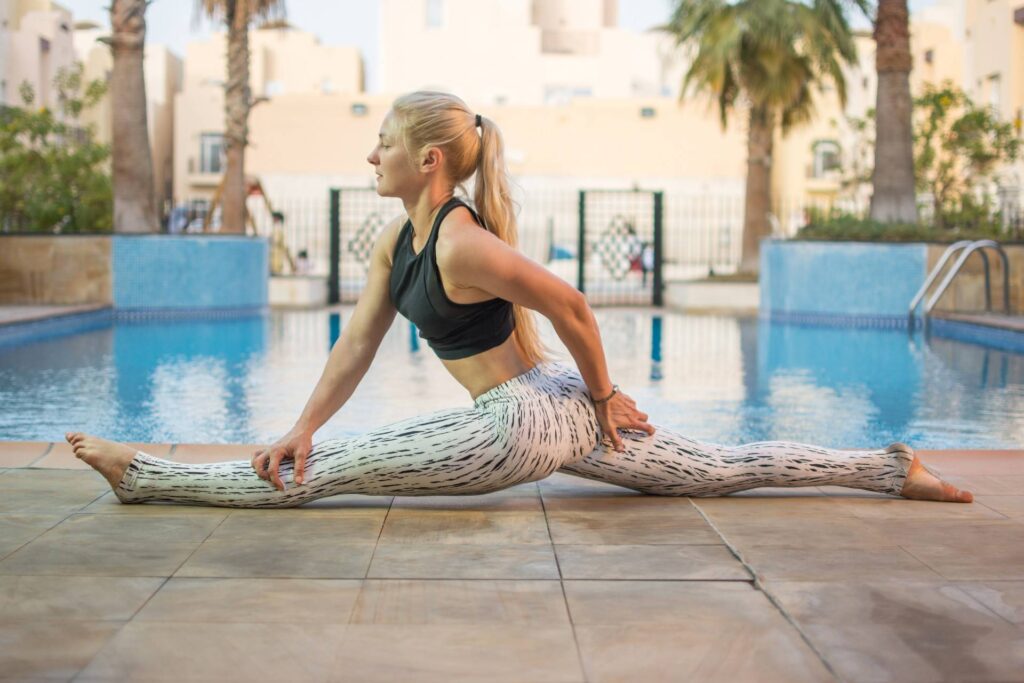
Can You Do Front Splits if You Are New to Gymnastics?
Yeah, they can. The same as an adult can. But the real question you’re likely thinking is, “Are children better at splits than adults are?”. And the research is limited, and it goes in both the yes and no directions, with the final conclusions stopping at the word “plausable”. The plausibility, however, is due to the lacking of a large-scale research.
For example, a study done by Sports Medicine-Open done in 2022, suggest that there is a window of opportunity where promoting flexibility in humans is a bit easier. And that window of opportunity is closer to a child’s age than it is to an adult. The reasons behind that are uncertain and inconclusive.
But there are theories that the lack of a stretching volume load effect in adolescents may be due to the faster linear growth of bones compared with muscles, which may reduce muscle–tendon extensibility in postural and biarticular muscles and induce substantial limitations on the rate of movement.
Since each child develops according to his/her individual genetics and past experience regarding previous training methods used, flexible activities like yoga or dance can prove worthwhile in increasing body flexibility. This is furthered under perfect cueing from trained instructors who are cautious of preventing any unnecessary injury or disappointment during coaching sessions.
🔻21-DAY SPLIT CHALLENGE
Unleash your flexibility potential with our progressive 21-day training program.
This program will help you to:
- ✅ Achieve a Perfect Split
✅ Boost Hip Mobility
✅ Sculpt Aesthetic and Sexy Legs
✅ Banish Stiffness
✅ Enhance Mental Confidence
☀️ Specially designed for you by a Cirque du Soleil artist, use it!
FAQ
Are Front Splits or Side Splits Harder?
Side splits are generally considered to be more difficult than front splits. They require a greater range of motion in the hips and adductors, making them more demanding for most people. They also usually take more time.
Can Anyone Do the Front Splits?
Yes. If the conditions allow for it – anyone can reach them. The time it will take varies greatly, as well as your personal and subjective way of approaching the task, dealing with the challenge and obstacles, and your own way of deciding whether you want to give up or push through. All these factors vary from human to human – we’re all different. But again, yes, anyone can do front splits.
Conclusion
Taking on front splits presents an arduous yet satisfying goal within flexibility training – one that anyone can aspire towards through disciplined training, dedication and perseverance. Remember that safety comes first by maintaining awareness of your body throughout this process while enjoying each step as they come.
From you, the reader, I want to know a lot! Can you do front splits? If not, do you have the motivation to get there, but you have reservations? If yes, when did you learn to do them; as a child or as an adult. And how did you find the journey from zero to hero?
I’ve spoken to so many people about the topic of front splits, and the conversations have been extremely educational and insightful.
So, please, if you have anything to add (questions, tips, tricks, personal experiences, suggestions, or anything else) – leave a comment in the comment section below, and let’s learn more about this topic together!
Also read:
- Are Handstands Good for You
- How to Do a Wall Handstand
- Handstand Drills
- How to Do a Press Handstand
- Stretches for Splits
- Side Splits
- How to Work up to a Handstand
References:
- Overtraining and Recovery // SpringerLink: https://link.springer.com/article/10.2165/00007256-199826010-00001
- s There a “Window of Opportunity” for Flexibility Development in Youth // NCBI: https://www.ncbi.nlm.nih.gov/pmc/articles/PMC9259532/
- Effectiveness of diaphragmatic breathing for reducing physiological and psychological stress // NCBI: https://pubmed.ncbi.nlm.nih.gov/31436595/
- Isometric Exercise // ScienceDirect: https://www.sciencedirect.com/topics/medicine-and-dentistry/isometric-exercise
- Muscle strain injuries // NCBI: https://pubmed.ncbi.nlm.nih.gov/8947416/
- Why it’s important to cool down after exercise, according to the science // LeveScience: https://www.livescience.com/why-its-important-to-cool-down-after-exercise-according-to-the-science
- Effectiveness of a stretching program on anxiety levels of workers in a logistic platform // NCBI: https://pubmed.ncbi.nlm.nih.gov/23764394/
- Proprioception // ScienceDirect: https://www.sciencedirect.com/topics/neuroscience/proprioception
Why Trust Us?
With over 20 years in Olympic Weightlifting, our team does its best to provide the audience with ultimate support and meet the needs and requirements of advanced athletes and professional lifters, as well as people who strive to open new opportunities and develop their physical capabilities with us.
By trusting the recommendations of our certified experts in coaching, nutrition, dietology, and sports training programming, as well as scientific consultants, and physiotherapists, we provide you with thorough, well-considered, and scientifically proven content. All the information given in the articles concerning workout programming, separate exercises, and athletic performance, in general, is based on verified data. We ensure that you can rely on our professionals’ pieces of advice and recommendations that can be treated as personalized ones which will benefit you and fully meet your needs.
The product testing process is described in more detail here
Author: Oleksiy Kononov
Former Cirque Du Soleil Artist
Ukrainian Gymnast
More than 25 years ago Oleksiy started his sports career. He major in gymnastics which is definitely not an easy sport to go in for!
To become an athletic champion (in Ukraine, for instance, we mean here the title of “Master of Sports”) in gymnastics, one needs to spend at least 10 years and start training no later than being six years old. As for Oleksiy, he has fulfilled all the criteria.
During this period of time, definitely not short, he managed to become:
- Master of Sports, Champion of the State and International Tournaments;
- Member of the national team of Ukraine, having a perfect opportunity to train the best team ever!
- Part of Cirque Du Soleil team (as an artist).

